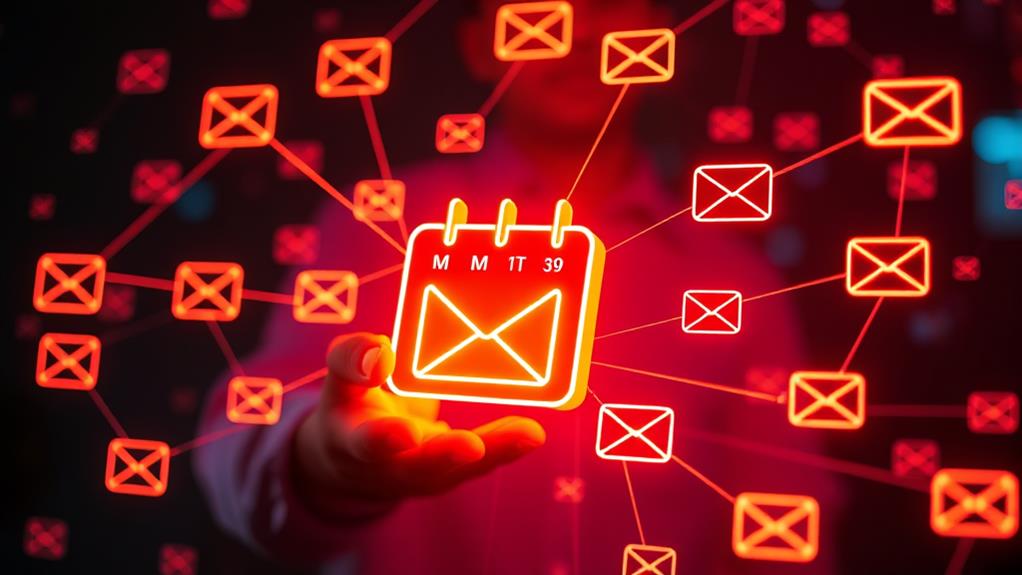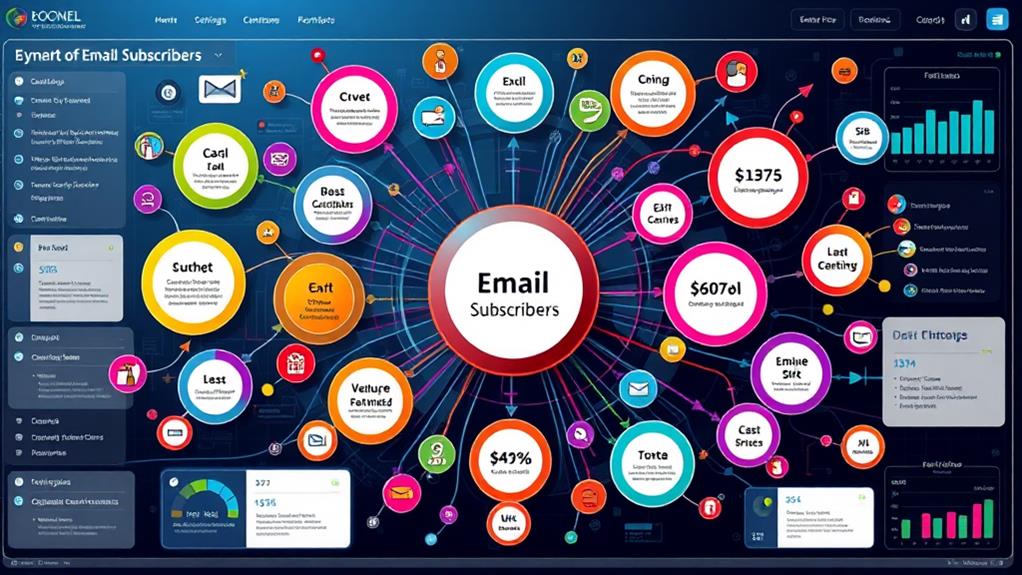Maintaining email list hygiene is critical for successful email marketing campaigns. An email list depreciates by approximately 25% annually, with up to 30% of addresses becoming outdated. This leads to high bounce rates that can damage deliverability and sender reputation. Regular audits and email validation remove inactive and invalid contacts, boosting engagement metrics like open rates by 20% and click-through rates by 30%. Additionally, a clean list can achieve over 90% inbox placement and up to 50% higher ROI. Embracing effective strategies for list hygiene not only optimizes marketing efforts but also protects against potential risks and inefficiencies. Explore further to access the full potential.
Key Takeaways
- Regular email list cleaning improves deliverability by maintaining bounce rates below 3-5%.
- Removing inactive subscribers enhances engagement metrics like open and click-through rates.
- Clean lists optimize marketing ROI by focusing on active, engaged recipients.
- Email verification tools prevent invalid addresses, reducing spam risks and compliance issues.
- Biannual audits ensure list accuracy, removing outdated and unengaged contacts.
Importance of Email List Hygiene
In the domain of digital marketing, maintaining email list hygiene is of utmost importance, as an average email list depreciates by approximately 25% annually, with nearly 30% of addresses becoming outdated each year. This underscores the essential role of email validation in sustaining subscriber retention and optimizing marketing efforts.
Without diligent list management, marketers face high bounce rates, which can severely affect deliverability and tarnish sender reputation, increasing the risk of being blacklisted by email service providers.
Email validation is a proactive measure that guarantees only valid, engaged contacts remain on lists, reducing the likelihood of encountering spam traps and protecting brand reputation. Engaged recipients on a meticulously curated list enhance open rates, click-through rates, and conversions, directly impacting the return on investment (ROI) of email campaigns.
Establishing a robust email validation process, coupled with regular audits, is crucial for maintaining a high-quality database.
Furthermore, employing best practices such as double opt-in mechanisms fortifies the subscriber base, fostering trust and credibility with recipients.
Benefits of a Clean Email List
Maintaining a clean email list is essential for optimizing deliverability rates, ensuring that over 90% of emails successfully reach the inbox, compared to remarkably lower rates for unclean lists.
This practice not only enhances engagement metrics—with potential increases of 20% in open rates and 30% in click-through rates—but also facilitates cost efficiency by reducing marketing expenses by up to 25% through targeted communications.
Consequently, businesses benefit from a higher return on investment, leveraging active subscriber engagement to achieve a 50% higher ROI compared to reaching out to unengaged contacts.
Improved Deliverability Rates
A significant advantage of maintaining a clean email list is the marked improvement in deliverability rates. Delivery optimization is achieved when the list consists of engaged recipients who have actively opted in. This reduces the likelihood of emails being labeled as spam, thereby safeguarding your sender reputation.
Recipient segmentation further enhances deliverability by targeting messages to those most likely to engage, which boosts open and click-through rates. The process of cleaning your email list guarantees the removal of inactive or incorrect addresses, keeping bounce rates below the ideal threshold of 3-5%. This proactive management is essential for maintaining a positive rapport with email service providers.
Regular list maintenance also helps to avoid spam traps, which can result from neglected or outdated email addresses. Such traps can severely impact your domain's deliverability status.
The correlation between a clean list and improved deliverability cannot be overstated, as it translates to tangible benefits for marketing campaigns, including:
- Higher Open Rates: Engaged recipients are more likely to open emails, increasing visibility.
- Increased Conversions: Targeted messages foster conversions.
- Enhanced Brand Credibility: Trust is bolstered, reflecting positively on overall brand perception.
Enhanced Engagement Metrics
Building on the improved deliverability rates achieved through diligent email list hygiene, enhanced engagement metrics present another compelling advantage. By ensuring subscriber engagement and content relevance, a clean email list can considerably boost open rates and click-through rates. Data indicates that targeted communication reaches engaged recipients more effectively, increasing engagement metrics by up to 50%. This translates into more meaningful interactions with your audience.
| Metric | Improvement Rate |
|---|---|
| Open Rates | Up to 50% |
| Click-Through Rates | Up to 760% more revenue |
| ROI | $42 for every dollar spent |
A well-maintained email list means that every message is sent to an audience that is more likely to respond positively. For instance, engaged subscribers from a clean list are more likely to convert, as evidenced by an average ROI of $42 for every dollar spent on targeted email marketing. Additionally, removing inactive subscribers enhances overall email performance and sender reputation, which are critical for sustained engagement.
Regular updates and list cleaning provide better analytics, enabling marketers to make data-driven decisions. These decisions help refine engagement strategies, ensuring that the content remains relevant to the audience's needs and preferences, ultimately fostering stronger subscriber relationships.
Cost Efficiency Gains
Efficiency is at the core of cost-effective email marketing strategies. By maintaining a clean email list, businesses can achieve significant cost reductions, leading to increased profitability and ROI.
Removing inactive subscribers directly reduces sending costs, while also guaranteeing that marketing efforts target engaged recipients, thereby improving open and click-through rates. This results in more successful campaigns and higher revenue generation.
Here are three key benefits of list hygiene in achieving cost efficiency gains:
- Cost Reduction: Eliminating non-engaged subscribers decreases the volume of emails sent, cutting down on costs associated with email service providers. This streamlined approach guarantees resources are utilized effectively.
- Subscriber Retention: By focusing on active subscribers, companies enhance customer relationships through personalized communication. This targeted approach boosts engagement and loyalty, ultimately retaining valuable subscribers.
- Improved Analytics: A clean list provides accurate data for analytics, allowing businesses to make informed decisions. This precision in data analysis leads to optimized marketing strategies and better resource allocation.
Regularly cleaning the email list minimizes bounce rates, protecting the sender's reputation and reducing blacklisting risks.
Ultimately, list hygiene not only supports cost efficiency but also strengthens overall marketing effectiveness.
Common Issues With Unclean Lists
Unclean email lists present a significant challenge for marketers, as they often result in high bounce rates, which directly impact email deliverability and sender reputation. Common pitfalls include failing to regularly update subscriber information, leading to list decay and reduced accuracy in subscriber segmentation. Approximately 25% of email addresses change annually, and without consistent maintenance, contact lists become outdated. Such list degradation not only skews engagement metrics but also hampers the effectiveness of marketing campaigns.
| Issue | Consequence | Impact on Campaigns |
|---|---|---|
| High Bounce Rates | Low Deliverability | Damaged Sender Reputation |
| Outdated Information | List Decay | Inaccurate Subscriber Segmentation |
| Inactive Subscribers | Skewed Metrics | Misleading Campaign Effectiveness |
Moreover, sending emails to unclean lists raises the risk of encountering spam traps, which can lead to domain blacklisting. In addition, compliance risks arise from using unverified data, potentially resulting in unsolicited emails that violate regulations like GDPR or CAN-SPAM. Consequently, maintaining a clean list is imperative to mitigate these issues. The risks associated with unclean lists highlight the necessity of adopting robust email hygiene practices to protect brand integrity and enhance marketing performance.
Steps for Cleaning Your Email List
To maintain the integrity of your email marketing efforts, it is essential to systematically identify inactive contacts who haven't engaged in the past 3-6 months.
Employing sophisticated email verification tools can greatly reduce bounce rates by eliminating invalid addresses, thereby safeguarding your sender reputation.
In addition, conducting regular audits every six months will guarantee your list remains robust, with a bounce rate ideally below 3-5%, enhancing deliverability and overall campaign success.
Identify Inactive Contacts
A fundamental step in maintaining a healthy and effective email list is the identification of inactive contacts, which involves systematic analysis of subscriber engagement metrics.
Implementing robust inactive subscriber identification and engagement tracking strategies is essential for optimizing email list performance. By utilizing data cleaning software, businesses can efficiently analyze metrics such as open and click-through rates to pinpoint subscribers who haven't engaged in the last 3-6 months.
This proactive approach aids in maintaining a responsive audience and reduces the risk of emails landing in spam folders.
To effectively manage inactive subscribers, consider the following steps:
- Re-engagement Campaigns: Deploy targeted campaigns aimed at reactivating dormant subscribers. Personalized offers or surveys can encourage interaction and renew interest in your content.
- Bounce Rate Monitoring: Regularly track bounce rates, keeping them below the 3-5% threshold. Increased bounce rates often signal an accumulation of inactive contacts, necessitating prompt action.
- Routine Audits: Conduct biannual audits of your email list. This practice not only identifies inactive users but also guarantees the removal of invalid or outdated addresses, maintaining the list's integrity.
Utilize Verification Tools
Moving from identifying inactive contacts to actively maintaining a clean email list, utilizing verification tools proves invaluable. By employing these tools, businesses can identify invalid email addresses, thereby reducing hard bounce rates and protecting their sender reputation. Critically, real-time validation filters out invalid addresses at the point of subscription, guaranteeing that user authentication is robust and compliant with legal regulations. This proactive approach not only minimizes the risk of sending unsolicited emails but also enhances deliverability rates.
| Benefit | Impact |
|---|---|
| Reduced Hard Bounce Rates | Protects sender reputation |
| Real-Time Validation | Filters invalid addresses instantly |
| Legal Compliance | Minimizes risk of unsolicited emails |
| Soft Bounce Management | Detects full inboxes/server issues |
| Improved Deliverability | Higher open and click-through rates |
Verification tools are also adept at managing soft bounces by detecting temporary issues like full inboxes or server problems. This capability guarantees better management and effective communication with subscribers. Ultimately, implementing these tools leads to higher open and click-through rates, boosting the overall effectiveness of email marketing campaigns. By maintaining a healthier email list from the outset, businesses can optimize engagement and achieve superior marketing outcomes.
Conduct Regular Audits
Regular audits are essential for maintaining a robust email list and enhancing email marketing performance. With email lists depreciating by approximately 25% annually, conducting audits at least twice a year is critical.
This audit frequency guarantees that inactive or invalid addresses are identified and removed, supporting list health and engagement. By employing data analysis through data cleaning software, marketers can pinpoint structural issues and filter out low-engagement contacts, thereby maintaining peak list hygiene.
Here are three key steps to conduct effective email list audits:
- Monitor Bounce Rates: Regularly assess bounce rates and aim to keep them below 3-5%. High bounce rates can harm your sender reputation, impacting deliverability. Consistent monitoring helps mitigate these risks.
- Implement Systematic Removal: Use a systematic approach to remove contacts who have not engaged with your emails in the last 3-6 months. This reduces the risk of spam traps and enhances the quality of your list.
- Validate New Subscribers: Regularly assess and validate new subscribers using double opt-in processes. This guarantees that email addresses are accurate and subscribers are genuinely interested, fostering a more engaged audience.
Best Practices for List Maintenance
How can businesses guarantee their email marketing efforts are both effective and efficient? The key lies in diligent list maintenance. Begin with list segmentation and re-engagement strategies. By segmenting email lists based on subscriber engagement levels, businesses can conduct targeted re-engagement campaigns, increasing open rates by up to 20%. This tailored approach assures that content is relevant to the audience, fostering higher engagement.
Implementing a double opt-in process is another best practice, enhancing list accuracy by confirming that subscribers genuinely wish to receive emails. This step reduces future bounce rates, safeguarding sender reputation. Regular audits, conducted at least biannually, are essential for pinpointing and purging invalid addresses, thereby bolstering deliverability.
| Practice | Benefit |
|---|---|
| Double Opt-In | Confirms genuine interest, reduces bounce rates |
| Regular Audits | Identifies invalid addresses, improves deliverability |
| List Segmentation | Enhances re-engagement, boosts open rates by 20% |
| Email Verification Tools | Lowers bounce rates by removing up to 25% invalid emails |
In addition, using email verification tools can catch invalid addresses before they affect campaign metrics. Finally, a sunset policy for inactive subscribers—removing those unengaged for over six months—can further refine list quality, protect domain reputation, and increase overall engagement.
Reducing Spam and Legal Risks
Maintaining email list hygiene is crucial for reducing spam and legal risks. A clean email list is necessary for spam prevention, as it minimizes the likelihood of unsolicited emails reaching disengaged recipients and triggering spam complaints. High spam complaint rates can lead to domain blacklisting, severely impacting email deliverability and marketing effectiveness.
Employing robust compliance measures guarantees adherence to regulations such as GDPR and CAN-SPAM, reducing legal risks associated with unsolicited emails. Regular list maintenance prevents the accumulation of spam traps—outdated email addresses used to identify spammers. Spam traps can damage your sender reputation, which is essential for maintaining high deliverability rates.
Here's how maintaining list hygiene addresses spam and legal issues:
- Engaged Subscribers: Regularly updated lists guarantee emails are sent to recipients interested in your content, reducing spam complaints and fostering positive relationships.
- Consent-Based Lists: Implementing proper list hygiene practices guarantees compliance with legal requirements, avoiding penalties for unsolicited emails.
- Protecting Reputation: By preventing spam traps, a clean list safeguards your sender reputation, which is crucial for effective email marketing.
Ultimately, effective email list hygiene not only enhances marketing success but also safeguards against potential legal and reputational ramifications.
Tools for Effective Email Hygiene
To maintain ideal email list hygiene and mitigate the risks of spam and legal issues, leveraging specialized tools is essential. Email validation tools like ZeroBounce and NeverBounce play a crucial role by identifying invalid email addresses in real-time. This proactive approach greatly reduces bounce rates, thereby enhancing the overall quality of your email list.
Similarly, Mailgun Validate offers a robust API for checking the validity and formatting of email addresses, ensuring that only legitimate contacts are retained.
Regular audits are a critical component of thorough list management strategies. Tools such as BriteVerify can detect inactive subscribers and spam traps, which, if left unchecked, can severely damage your sender reputation.
By using EmailListVerify, marketers can cleanse their lists effectively by removing duplicates and confirming the validity of addresses before launching campaigns, maximizing deliverability and engagement rates.
Furthermore, segmentation tools like HubSpot and ActiveCampaign facilitate effective list management strategies by targeting engaged subscribers. These tools help marketers efficiently manage unengaged contacts, providing opportunities for re-engagement while maintaining a clean and responsive email list.
Frequently Asked Questions
What Is Email List Hygiene?
Email list hygiene involves email verification to guarantee subscriber engagement by maintaining accurate, valid contacts. Regular cleaning prevents high bounce rates, improves deliverability, and protects sender reputation, ultimately enhancing the effectiveness of email marketing campaigns.
Is There a Way to Clean Your Email?
To effectively clean your email list, leverage email verification tools to eliminate invalid addresses, and analyze engagement metrics to identify inactive subscribers. This approach enhances deliverability and optimizes engagement, ensuring a robust and responsive email list.
Should I Clean up My Email List?
Yes, cleaning your email list is essential for enhancing email engagement and subscriber retention. By maintaining a healthy list, you improve deliverability, reduce bounce rates, and guarantee accurate engagement metrics, ultimately boosting overall campaign performance and ROI.
Why Is Good Email List Hygiene Deleting Anyone Who Hasn T Opened Email From You in 6 Months Important?
Good email list hygiene, including removing subscribers inactive for six months, is essential for enhancing email engagement and subscriber retention. This practice improves deliverability, reduces costs, and increases ROI by maintaining a responsive and engaged audience.
Conclusion
Maintaining ideal email list hygiene is essential for enhancing engagement rates and ensuring compliance with legal standards. A clean email list reduces bounce rates, improves deliverability, and minimizes the risk of being flagged as spam. By systematically removing inactive or invalid addresses and implementing best practices, organizations can safeguard their sender reputation and maximize return on investment. Utilizing specialized tools further streamlines this process, ensuring that email communications remain effective and legally compliant, thereby driving business success.




